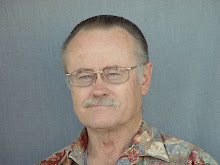A Boy, a Frog and the Other Side of the Paper
A few days ago I visited a student teacher subbing for her master teacher in a first grade general education class. The children were finishing up work for an Open House display. One of the tasks was completing a drawing of a frog on a 9" x 18" white drawing paper.
One boy completed his drawing and sat admiring it. He stood up, went over to an instructional aide and thrust the picture toward her face trying to scare her with his drawing. He repeated this with the other aide, the student teacher, and several of his classmates.
The problem was that while he was looking at his drawing of the frog, he was trying to scare others with the blank side of the paper. He did not realize that no one else could see what he was seeing. I knew this incident was a great philosophical moment, so I took anecdotal notes.
Later, as I thought about the boy and his frog, I saw this as a perfect example of social construction and societal perceptions. When we look at people and events, we have to realize that no one else is seeing what we see. It is only when we are totally aware that the other side of the picture is blank, or something completely different, that we can compassionately communicate, understand, and relate to others. This is especially true when we relate to individuals whose life experiences are so totally different from ours.
When we understand that we are almost incapable of knowing what it is like to be extemely poor with no prospects, homeless, mentally ill, or developmentally disabled we can begin to have a glimmer of hope of creating a culture of social justice. Growing up or living in circumstantial poverty is far different from growing up in generational poverty. Having a mental illness is totally different from being developmentally disabled. If one doesn't experience a developmental disability or have a child with one, there is no way to understand what it is like.
It is possible to be an "expert" in the diagnosis, care, and "treatment" of individuals with intellectual disabilities and have very little understanding of the real life experience of the subjects of their expertise. It is also possible to have true compassion and empathy for the developmentally disabled and not really understand the interplay between strengths, deficits, spike skills, and processing difficulties. I feel that we have to be honest, strive for humility, and understand that we are incapable of understanding the lived lives of others.
One boy completed his drawing and sat admiring it. He stood up, went over to an instructional aide and thrust the picture toward her face trying to scare her with his drawing. He repeated this with the other aide, the student teacher, and several of his classmates.
The problem was that while he was looking at his drawing of the frog, he was trying to scare others with the blank side of the paper. He did not realize that no one else could see what he was seeing. I knew this incident was a great philosophical moment, so I took anecdotal notes.
Later, as I thought about the boy and his frog, I saw this as a perfect example of social construction and societal perceptions. When we look at people and events, we have to realize that no one else is seeing what we see. It is only when we are totally aware that the other side of the picture is blank, or something completely different, that we can compassionately communicate, understand, and relate to others. This is especially true when we relate to individuals whose life experiences are so totally different from ours.
When we understand that we are almost incapable of knowing what it is like to be extemely poor with no prospects, homeless, mentally ill, or developmentally disabled we can begin to have a glimmer of hope of creating a culture of social justice. Growing up or living in circumstantial poverty is far different from growing up in generational poverty. Having a mental illness is totally different from being developmentally disabled. If one doesn't experience a developmental disability or have a child with one, there is no way to understand what it is like.
It is possible to be an "expert" in the diagnosis, care, and "treatment" of individuals with intellectual disabilities and have very little understanding of the real life experience of the subjects of their expertise. It is also possible to have true compassion and empathy for the developmentally disabled and not really understand the interplay between strengths, deficits, spike skills, and processing difficulties. I feel that we have to be honest, strive for humility, and understand that we are incapable of understanding the lived lives of others.
Labels: Disability, Social Construction


1 Comments:
People should read this.
Post a Comment
<< Home